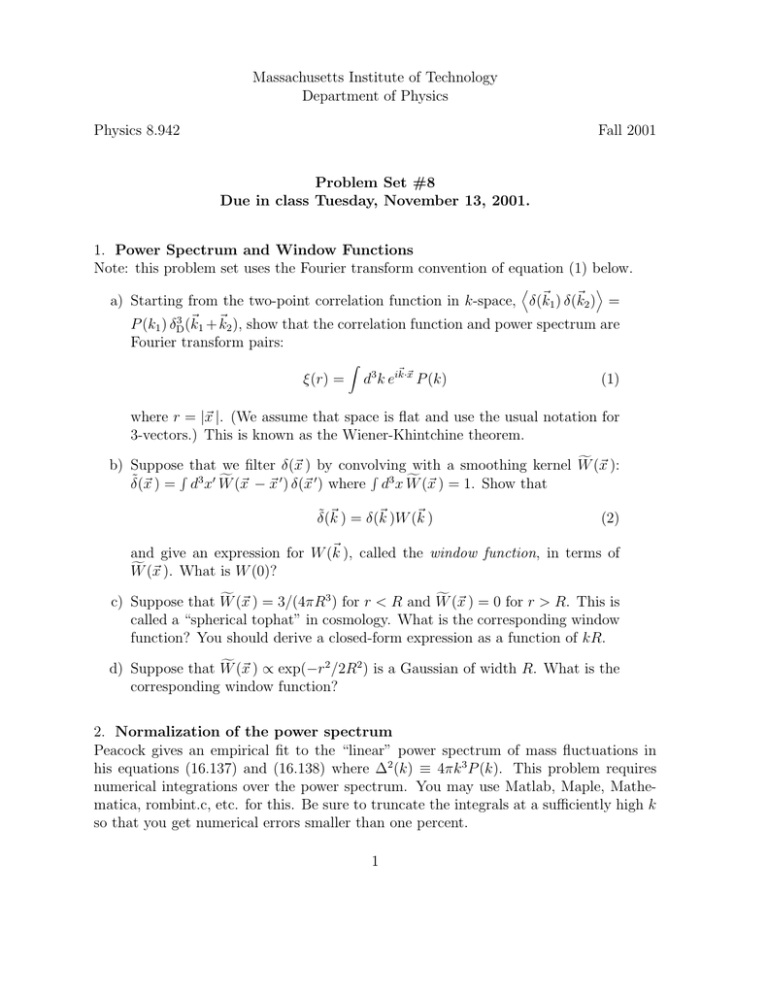Document 13650306
advertisement

Massachusetts Institute of Technology Department of Physics Physics 8.942 Fall 2001 Problem Set #8 Due in class Tuesday, November 13, 2001. 1. Power Spectrum and Window Functions Note: this problem set uses the Fourier transform convention of equation (1) below. � � a) Starting from the two­point correlation function in k­space, δ(�k1 ) δ(�k2 ) = 3 � (k1 + �k2 ), show that the correlation function and power spectrum are P (k1 ) δD Fourier transform pairs: � ξ(r) = � d3 k eik·x� P (k) (1) where r = |�x |. (We assume that space is flat and use the usual notation for 3­vectors.) This is known as the Wiener­Khintchine theorem. � (� x ): b) Suppose� that we filter δ(�x ) by convolving with a smoothing kernel W � 3 � � � � 3 � ˜ δ(�x ) = d x W (�x − �x ) δ(�x ) where d x W (�x ) = 1. Show that δ̃(�k ) = δ(�k )W (�k ) (2) and give an expression for W (�k ), called the window function, in terms of � (� W x ). What is W (0)? � (� � (� c) Suppose that W x ) = 3/(4πR3 ) for r < R and W x ) = 0 for r > R. This is called a “spherical tophat” in cosmology. What is the corresponding window function? You should derive a closed­form expression as a function of kR. � (� d) Suppose that W x ) ∝ exp(−r2 /2R2 ) is a Gaussian of width R. What is the corresponding window function? 2. Normalization of the power spectrum Peacock gives an empirical fit to the “linear” power spectrum of mass fluctuations in his equations (16.137) and (16.138) where Δ2 (k) ≡ 4πk 3 P (k). This problem requires numerical integrations over the power spectrum. You may use Matlab, Maple, Mathe­ matica, rombint.c, etc. for this. Be sure to truncate the integrals at a sufficiently high k so that you get numerical errors smaller than one percent. 1 � � 1/2 a) Using Peacock’s spectrum, compute σ8 = δ̃ 2 where δ˜ is the density perturbation filtered with a spherical tophat of radius 8 h−1 Mpc. Compare with Peacock equation (16.136) for Ωm = 0.35. b) Using the cosmological Poisson equation �2 φ = 4πGρ̄m δ for a = 1, determine the power spectrum of the gravitational potential in terms of Peacock’s Δ2 (k). Show that k 3 Pφ (k) → constant as k → 0. Assuming that the gravitational potential has decayed by a factor g(Ωm ) < 1 since recombination, compute Qrms−PS in the Sachs­Wolfe approximation (Problem 1 of Problem Set 6) and compare with the COBE measurement Qrms−PS = 18 µK. 2



